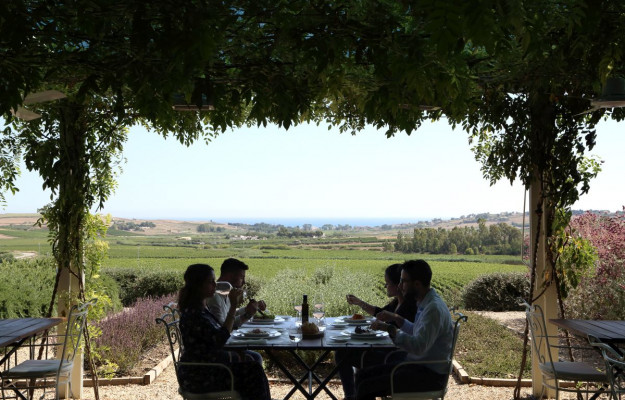Already among the most successful phenomena of the world of wine and food in Italy, wine tourism is stronger than the pandemic: in time of Covid, the number of experiences enjoyed is decreasing, but the number of tourists who traveled with the main reason of “living” wine and food is increasing by 10%. But besides being more and more, nowadays taste tourists are also more and more aware, active, demanding, innovative and attentive to safety and sustainability issues. So much so that the “maturity” acquired places them at the center of a scenario of more balanced development of the territories and makes them the “sentinels” of virtuous tourism, which contributes to the protection of local resources and landscape, which deseasonalizes and creates new balances between urban and rural. To say this, it is the Report on Italian Food and Wine Tourism 2021, edited by Roberta Garibaldi, edition n. 4 presented today at the Senate of the Republic in Rome, focused on the “Italian demand” that, in the absence of foreign tourists, will be the main target in the near future. From which it emerges how in 2020 Italian tourists, of all ages, have rediscovered Italy as a destination, a choice almost forced by the restrictions imposed on international travel. This has also determined a desire to deepen the knowledge of the heritage of territorial flavors. And it will be the same in 2021, since for 71% the presence of food and wine experiences is important in the choice of travel (it was 59% in 2019), with 33% opting for those in their own Region, 32% in other territories and only 19% abroad. Tired of staying at home, there is a desire to go outdoors in contact with nature and novelty (62%), which means quality wine & food experiences that go beyond the classic winery visits and marry new trends such as bike&gusto, wellbeing and bleisure linked to smart working. And to do all this in safety (for 76%, tracking is important). All of this is done by informing themselves, recounting their experience and staying in touch with the companies and territories they visit more and more through social networks. Their favorite destination? Seaside resorts, which are the gateway to food and wine experiences in the hinterland (53% of tourists), ahead of cities of art and mountain destinations. In particular, among the most desired regions, Sicily stands out, followed by Emilia Romagna, Campania, Puglia and Tuscany, while among the cities in the lead is Naples, followed by Bologna, Palermo, Florence and Rome.
“The growth of the food and wine phenomenon is constant - explains Garibaldi - if in 2016 only 21% of respondents had made at least one trip with main motivation related to this area in the previous three years, then rise to 30% in 2018 and 45% in 2019, with the analysis 2021 the percentage has grown to 55%. However, the impact of the crisis triggered by Covid weighs on the number of experiences enjoyed, which decrease by an average of 27% over 2019, and on spending power: 31% say they have allocated a lower budget in 2019, while 27% have more resources”,
The rediscovery of Italy and its territories is also linked to the desire to live in the open air, which pushes tourists to look for accommodations such as agritourisms (86% intend to stay there) and country relais (59%), with a search for innovative solutions, including food-and-wine themed hotels (56%), glamping (29%) and tree houses (32%). In the choice of hotels, the presence of an offer that enhances typical local foods appears to be increasingly decisive and 80% of respondents expect a breakfast based on local products. The pandemic has modified the choices of the consumer, who wants to be the protagonist of experiences in direct contact with nature. The traditional visits in the winery, perceived as too similar by 60% of tourists (+6%) and the “passive” approach, is replaced by the will to actively take part in the visit of the winery, becoming himself an element of that agricultural community (for example with the grape harvest) and acting in harmony with nature (the percentage of those who want to reach the winery by bike doubles, the share of those who would like to use the car decreases by 9 points).
The acquired awareness of social-environmental issues transforms the enogastronomic tourist in a sort of stakeholder of the place and/or of the virtuous company, which operates in harmony with its territory. The choice of a destination becomes a sort of “award” to the areas and farms that worked for an authentic and harmonic development, revaluating and protecting local knowledge and culture, creating new job opportunities especially for young people and women. And the loyalty of the tourist, with the purchase of products, appears to be a logical consequence of the experience. The wellbeing trend is also in full development. 65% of tourists would be interested in attending courses and workshops in production companies with useful information on psychophysical wellbeing, 64% would like to practice outdoor sports. Offers such as yoga, forest bathing and the possibility of practicing sports in rural areas (gym, trekking, bike) assume particular importance in the decisions to visit territories and f&b companies.
The ways of accessing the experience are also changing, and the digital revolution is gaining significant weight in the pre- and post-experiential phases. While word of mouth among friends and acquaintances continues to prevail in the choice of visiting a company or a territory (55%), the research shows, however, an increasingly important weight of social networks with Instagram growing (+4%) compared to Facebook, which continues to be the most used social tool. In terms of booking methods, as an effect of the pandemic and the need for a reservation or consequent possibility of cancellation, there is a greater use of direct telephone calls (62%) or email (46%), preferred to contact through institutional portals or travel agencies. On the other hand, digital has become the reference tool for the phase following the direct experience, from the purchase of products with home delivery (which interests 70% of those interviewed) to digital tastings and the possibility of joining wine clubs. Another data, 57% of Italians consider wineries as places where they can have business meetings.
The ranking of the foreign countries considered as the best destination for enogastronomy has Spain in first place, followed by France and then Greece. The French capital, Paris, gains the first position among the favorite foreign cities for enogastronomy, followed by Barcelona and Madrid.
“The message given by Premier Draghi to the world market in recent days at the conclusion of the G20 is very clear - said Massimo Garavaglia, Minister of Tourism - Italy is open, the tourism industry has restarted its engines and we are ready to start again. And the data show that one of the strong points is wine and food. Just the 7 guidelines approved by the Italian G20 are in line with those of food and wine tourism: safe mobility, which means being outdoors, bike&gusto, wine trekking; crisis management, which means making tourism strong even in times of difficulty and food and wine has held up; resilience, or resisting despite everything; sustainability; green transformation, which means tourism that looks at the environment and integrates with agriculture; digital transition, on which we must push to make food and wine even stronger; and finally, investment in infrastructure to improve travel as well. In this way we have the possibility to restart very quickly and food and wine has the run-up, but we need an ad hoc Plan with the Ministry of Agriculture and Cultural Heritage”.
According to Gian Marco Centinaio, Undersecretary of Agriculture who, yesterday, met the newborn Table of Food and Wine Tourism (established by the City of Wine and Oil, Movimento Turismo del Vino e dell'Olio, Strade del Vino, dell'Olio e dei Sapori and Unione Italiana Vini, ed) “with the aim of opening one even interministerial”, food and wine tourism in Italy that today has its framework law, “has huge margins for growth. The excellences of Made in Italy can become a driving force for the whole sector. An emblematic example is represented by wine, union between a product and the valorization of its territory. Each of our regions is a journey of taste. In the post-pandemic future, I am sure there will be many opportunities in the name of good living and in respect of environmental sustainability”.
“Food and wine has contributed to maintain a strong affection for Italy in this difficult time and over time has also transformed tourists into travelers - concluded Giorgio Palmucci, president of Enit-National Tourism Agency, which is sponsoring the Report with Fondazione Qualivita, Ismea and Touring Club Italiano, alongside the support of PromoTurismo Fvg, Visit Emilia, Valdichiana Living and Unicredit - the enjoyment of themed experiences becomes common heritage, generating tourist flows distributed throughout the year and in lesser-known locations. These experiences have changed the geography of tourism, introducing new forms of approach to knowledge of the area, and also represent a driving force for businesses, a profound renewal of tourism models, increasingly opening up supply in the direction of sustainability, and an adaptation to new trends in demand and supply oriented towards the quality of reception. The Italian tourism system is becoming increasingly aware. We are witnessing a transformation in catering, which is one of the primary reasons for travel, especially for foreign tourists. And often it is the discovery of enogastronomical experiences to prolong the travel experience”.
Copyright © 2000/2025
Contatti: info@winenews.it
Seguici anche su Twitter: @WineNewsIt
Seguici anche su Facebook: @winenewsit
Questo articolo è tratto dall'archivio di WineNews - Tutti i diritti riservati - Copyright © 2000/2025









































































































































































































